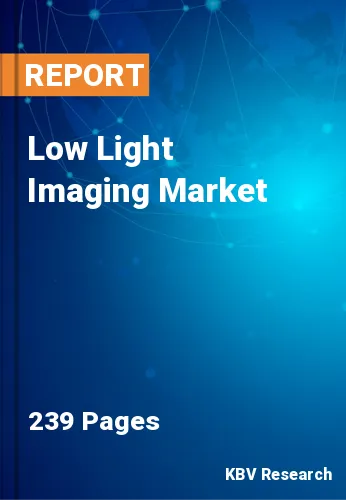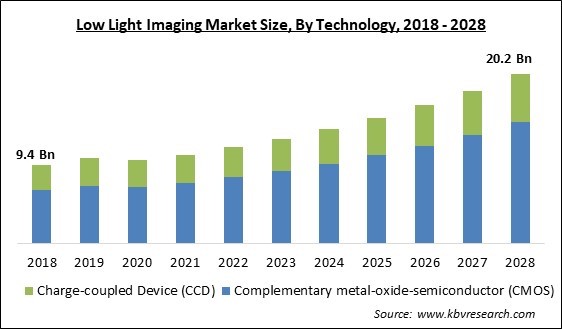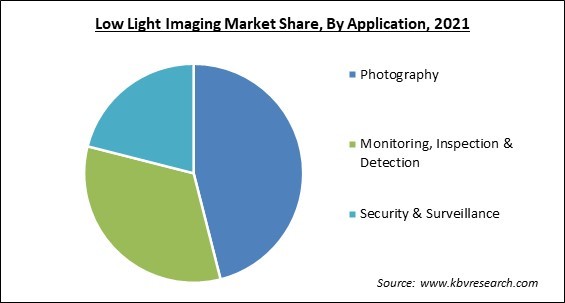
The Global Low Light Imaging Market size is expected to reach $20.2 billion by 2028, rising at a market growth of 9.9% CAGR during the forecast period.
Due to low illumination, images taken in outdoor scenes can be severely affected. In addition, low dynamic range and excessive noise levels in these photos may impact how computer vision algorithms are presented in general. Low-light imaging is used to increase the visibility of an image and make computer vision algorithms robust in low light.

To better serve applications in photography, cinematography, security, and medical and life sciences research, the low-lighting imaging industry is growing rapidly. The development of low-light imaging for improved applications results from numerous ground-breaking discoveries in this field.
The sensitivity of IP cameras has been substantially increased because of advances in low-light technology, making it possible to capture color images with as little as 0.1 lux illumination. The industry has also seen advancements in chipsets, which have contributed significantly to supplying greater processing capacity to execute more complex algorithms for low-light image processing to portray more activity and better adapt to scenes.
Low-light cameras have continued to advance and change mainly due to their capacity to recreate low-light photos in a precise color. A large low-light sensor, big-aperture lenses, and appropriate backlighting or IR illumination are needed for the best performance in low-light conditions. In addition, AI technology is anticipated to significantly advance low-light technology in the future, enhancing the camera's image.
The market for low-light imaging suffered from the COVID-19 pandemic. Most nations experienced economic contraction during the pandemic, which had a detrimental impact on photography's financial aspects. Nowadays, taking pictures is more of a hobby than a need, and demand varies depending on consumer affluence. An overall fall in demand for photography services was seen as the pandemic spread. It consequently impacted the makers because its principal uses were in the areas of hunting and wildlife photography, which were prohibited during the lockdown.
One of the key drivers boosting the market for low-light photography is the increasing use of smartphones and tablets with numerous cameras. OEMs are concentrating on creating image sensors with smaller footprints and increased features like low-light visibility, and high-quality pixels as the relevance of cameras and picture quality in smartphones grows. Buyers of smartphones worldwide are progressively focusing heavily on camera specs, and businesses are producing more and more camera-focused devices.
In all fields, including security, healthcare, and defense, clear visuals are required. In low-light conditions, traditional cameras are unable to capture vivid images. New imaging technologies have improved the performance of image sensors in low-light imaging applications such as SWIR image sensors, organic photodetectors, hyperspectral imaging, event-based vision, and flexible detectors. The advantages of these new technologies include flexibility, cost reduction, spatially variable sensitivity, higher temporal resolution, high-resolution global shutters, and expanded dynamic range.
Since the quality of smartphone photography has significantly improved, many people no longer carry or buy a digital still camera. The average person may easily capture good photos with today's smartphones, while pros and photo aficionados can get better pictures with expensive cameras and lenses. As a result, global exports of digital still cameras fell by 93% between 2011 and 2021, according to the Camera & Imaging Products Organization (CIPA), a business association with its headquarters in Japan.
Based on technology, the Low Light Imaging Market is categorized into Complementary Metal-oxide-semiconductor (CMOS) and Charge-coupled Devices (CCD). In 2021, CMOS technology generated the highest revenue share. The performance of image sensors has improved owing to developments in CMOS image sensor technology, increasing the use of CMOS in consumer devices. The market for CMOS technology has grown due to improved performance and low cost of CMOS sensors.

Based on Application, the Low Light Imaging Market is categorized into Security & Surveillance, Photography, and Monitoring, Inspection & Detection. Security & Surveillance segment is growing at a rapid growth rate during the anticipated period. It is frequently necessary to monitor settings that can be either highly bright or very dark in security and surveillance applications. Therefore, a sensor used in these applications needs to function effectively in low light and have a wide dynamic range.
Based on Industry Vertical, the Low Light Imaging Market is categorized into Consumer Electronics, Automotive, Medical & Life Sciences, Military & Defense, and Industrial, Commercial, & Residential Infrastructure. Medical & Life Sciences segment registered the prominent revenue share due to the advancements in medical devices for complicated operations. A low-light imaging usage in medical field is evident with the availability of light imaging enabled endoscopic equipment used for both surgical and diagnostic procedures.
| Report Attribute | Details |
|---|---|
| Market size value in 2021 | USD 10.6 Billion |
| Market size forecast in 2028 | USD 20.2 Billion |
| Base Year | 2021 |
| Historical Period | 2018 to 2020 |
| Forecast Period | 2022 to 2028 |
| Revenue Growth Rate | CAGR of 9.9% from 2022 to 2028 |
| Number of Pages | 239 |
| Number of Tables | 370 |
| Report coverage | Market Trends, Revenue Estimation and Forecast, Segmentation Analysis, Regional and Country Breakdown, Companies Strategic Developments, Company Profiling |
| Segments covered | Technology, Application, Vertical, Region |
| Country scope | US, Canada, Mexico, Germany, UK, France, Russia, Spain, Italy, China, Japan, India, South Korea, Singapore, Malaysia, Brazil, Argentina, UAE, Saudi Arabia, South Africa, Nigeria |
| Growth Drivers |
|
| Restraints |
|
Based on region, the Low Light Imaging Market is categorized into North America, Europe, Asia Pacific, and LAMEA. During the anticipated timeframe, North America is anticipated to hold the second-largest market for low light imaging. The increase in technological advancements in the field of imaging technology for a variety of application areas, like medical, life sciences, electronics, and automotive, is driving the expansion of the low light imaging market in North America.
Free Valuable Insights: Global Low Light Imaging Market size to reach USD 20.2 Billion by 2028
The market research report covers the analysis of key stake holders of the market. Key companies profiled in the report include Samsung Electronics Co., Ltd. (Samsung Group), Sony Corporation, Teledyne FLIR LLC, STMicroelectronics N.V., Panasonic Corporation, Canon, Inc., ON Semiconductor Corporation, Hamamatsu Photonics K.K., PixArt Imaging, Inc., and OmniVision Technologies, Inc.
By Vertical
By Application
By Technology
By Geography
The global Low Light Imaging Market size is expected to reach $20.2 billion by 2028.
The Incorporation Of Low-Light Imaging Sensors Into Tablet And Smartphone Cameras are driving the market in coming years, however, Reduced Popularity Of Digital Still Cameras restraints the growth of the market.
Samsung Electronics Co., Ltd. (Samsung Group), Sony Corporation, Teledyne FLIR LLC, STMicroelectronics N.V., Panasonic Corporation, Canon, Inc., ON Semiconductor Corporation, Hamamatsu Photonics K.K., PixArt Imaging, Inc., and OmniVision Technologies, Inc.
The Consumer Electronics segment is leading the Global Low Light Imaging Market by Vertical in 2021 thereby, achieving a market value of $6.4 billion by 2028.
The Asia Pacific market dominated the Global Low Light Imaging Market by Region in 2021, and would continue to be a dominant market till 2028; thereby, achieving a market value of $7.4 billion by 2028.
Our team of dedicated experts can provide you with attractive expansion opportunities for your business.
